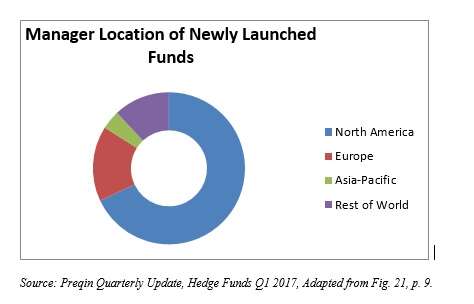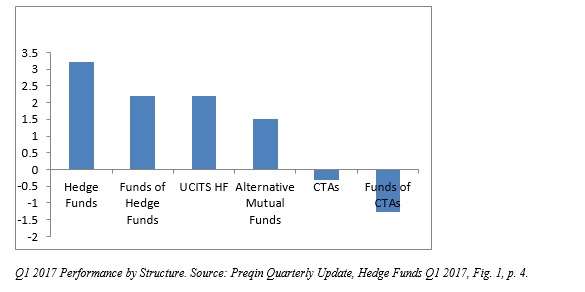Preqin’s review of the hedge fund space in the first quarter of 2017 describes the quarter as a time of “return to form” after a dry spell. Two thirds of the investors interviewed by Preqin at the end of 2016 had said that their hedge fund investments had failed to meet expectations.
In the first quarter 2017, though, returns were solid for most hedge fund strategies. The All-Strategies benchmark returned 3.21%, the best first quarter since 2013.
There were 82 hedge fund launches in the quarter, and more than two thirds of these were North America based. Indeed, the donut for manager location looks like this:

CTAs stood out as the only strategy that posted negative return this quarter, compounding the losses through the second half of 2016. Unsurprisingly, then, CTAs “may find fundraising more difficult in 2017.”
Preqin asks us to note that “all performance information includes preliminary data for March 2017 based upon returns reported to Preqin in early April,” and subject to change. That said …
Strategies and Structures
The most successful strategies in Q1 were those of the event-driven and the emerging markets funds. Event driven strategies generated positive numbers for each of the three months of the quarter, and their return for the quarter as a whole was 3.74%. Their twelve month return through March is at 17.72%.
The EM funds return for the first quarter was 4.45%, a comfortable win over the 2.13% generated by funds focused on the developed markets. Amongst the EM funds, those with a focus on Latin America have done the best over the past twelve months. Those with their focus in the Asia-Pacific region have done best over the last three months.
Despite the strong showing of the industry as a whole, Preqin says, some institutions remain cautious. There has been an especial decline in investor interest for funds of hedge funds, despite positive performance for the FoHFs in the first quarter. There were no new launches of such funds in the quarter.
Breaking the alternatives space down by structure, one gets this:

Fund Searches
The Preqin report also breaks down in various respects the identity of the investors who were issuing searches for hedge funds in Q1.
By geography, the largest proportion of searches was coming from investors based in North America, followed by those based in Europe.
When the break down is by the type of investor engaged in the search: 47% of searches were initiated by FoHFs, 19% by family offices. The remaining bits of that donut were many and, accordingly, small: 7% of searches were by asset managers, 6% by wealth managers, and so forth.
By strategy sought? The most searched-for fund type is long/short equity, which was targeted by a third of investors searching, though this represented a quarter- to-quarter decline.
Demand for event-driven strategies has risen. It represented only 10% of search demand in Q3 2016, then 13% in Q4, now 14% in Q1 2017.
League Tables
The report includes a number of league tables. For example, it ranks the top funds in net returns of equity strategies hedge funds in the 12 months ending March 31, 2017. The top performer here is Adaws Eagle Fund, of Adaws Capital, a U.S. based fund with a return for this period of 108.64%. That is followed by:
- Teraz Fund, managed by Spartan Fund Management, Canada, 99.35%
- Armistice Capital Fund, Armistice Capital, U.S., 92.56%
- Front Street Canadian Energy Resource Fund Series F, Front Street Capital, Canada, 84.16% and
- Atyant Capital India Fund, Atyant Capital, 78.04%.
The “winner” in that league table, Adaws Eagle, is described on the Adaws Capital website as a vehicle that offers investors “exposure to future trading by employing pattern recognition to anticipate market moves before they happen.”
The runner-up, Teraz, according to its managers’ website, offers exposure to small and micro-cap Canadian equities. Its strategy includes “deep value, arbitrage, theme investing and technical trading, and short positions in companies with suspected fraud, questionable management and over-promotion.”




